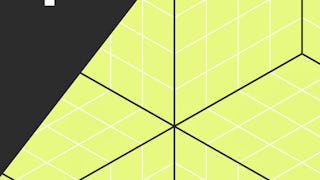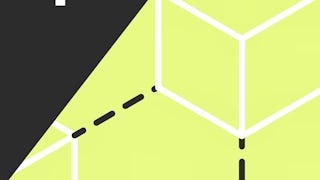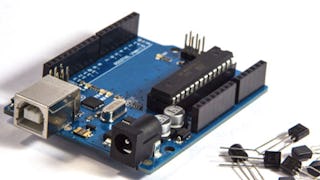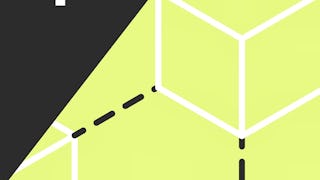This course introduces the Arduino, an open-source platform for building digital devices and interactive objects. You'll explore the Arduino board, its libraries, and the Integrated Development Environment (IDE). Learn to program Arduino using C code, control external devices via pins, and understand how shields extend functionality. This program is ideal for aspiring software developers, embedded systems engineers, and hobbyists eager to create interactive hardware projects.

Unlock access to 10,000+ courses with Coursera Plus. Start 7-Day free trial.

The Arduino Platform and C Programming
This course is part of An Introduction to Programming the Internet of Things (IOT) Specialization

Instructor: Ian Harris
215,229 already enrolled
Included with
(7,188 reviews)
What you'll learn
Outline Arduino board components and functions.
Program Arduino using C language fundamentals.
Debug embedded software on Arduino platforms.
Implement serial communication protocols.
Skills you'll gain
Details to know

Add to your LinkedIn profile
See how employees at top companies are mastering in-demand skills

Build your subject-matter expertise
- Learn new concepts from industry experts
- Gain a foundational understanding of a subject or tool
- Develop job-relevant skills with hands-on projects
- Earn a shareable career certificate

There are 4 modules in this course
Dive into the Arduino environment! This module introduces you to the Arduino board, its IDE, and powerful shields. You'll explore components, understand schematics, and learn to install and use the IDE for writing and uploading code. Discover how shields expand your projects' capabilities. This knowledge is key to transforming your C programming skills into tangible, interactive digital devices.
What's included
9 videos3 readings1 assignment1 peer review
Welcome to the foundational module on C programming! Here, you'll master the essential C language basics needed for Arduino projects. We'll cover syntax, variables, operators, conditionals, loops, and functions. By the end, you'll confidently write basic C code. This module is your crucial first step in bringing your digital device ideas to life with Arduino.
What's included
9 videos4 readings1 assignment1 peer review
Unlock the power of Arduino sketches! This module guides you through the structure of an Arduino program, from compilation to upload. You'll explore the Arduino IDE's role in the build process and master the `setup()` and `loop()` functions. Learn how to access Arduino pins directly from your code, enabling you to control physical components and build your own digital devices.
What's included
10 videos3 readings1 assignment1 peer review
Ready to tackle challenges? This module introduces essential debugging techniques for embedded software on Arduino. You'll learn about controllability and observability, and how to leverage the UART communication protocol and Serial library for effective debugging. Master these skills to ensure your Arduino projects run flawlessly and reliably.
What's included
9 videos4 readings1 assignment1 peer review
Earn a career certificate
Add this credential to your LinkedIn profile, resume, or CV. Share it on social media and in your performance review.
Instructor

Offered by
Explore more from Software Development
 Status: Free Trial
Status: Free Trial Status: Free Trial
Status: Free Trial Status: Free Trial
Status: Free TrialUniversity of California, Irvine
Why people choose Coursera for their career




Learner reviews
7,188 reviews
- 5 stars
73.30%
- 4 stars
21.39%
- 3 stars
3.68%
- 2 stars
0.86%
- 1 star
0.75%
Showing 3 of 7188
Reviewed on May 10, 2020
Course was great and interesting to learn. Explanation of concepts was nice and easy to grasp. After Completion of Course worth checking out the next Course in series of specialization.
Reviewed on Feb 5, 2019
Great ! Like in a real lecture. Anyone can learn from this course without a problem. like real lecture this has pop up question middle of the video and readings too. Nice
Reviewed on Oct 2, 2016
Good introductory courseThis course explains the basics of Arduino and explains C programming which is essential for Arduino sketches.This course motivated me in further learning about the Arduino.

Open new doors with Coursera Plus
Unlimited access to 10,000+ world-class courses, hands-on projects, and job-ready certificate programs - all included in your subscription
Advance your career with an online degree
Earn a degree from world-class universities - 100% online
Join over 3,400 global companies that choose Coursera for Business
Upskill your employees to excel in the digital economy
Frequently asked questions
The Arduino is an open-source hardware and software platform for building digital devices and interactive objects. You'll learn to create projects that sense and control the physical world, from simple LED controls to complex embedded systems.
This course focuses on C programming, the foundational language for interacting with the Arduino platform. You'll master C syntax, operators, functions, and control structures to program your Arduino.
While no prior Arduino experience is required, a basic understanding of programming concepts will be beneficial. The course covers C programming fundamentals from the ground up.
More questions
Financial aid available,
¹ Some assignments in this course are AI-graded. For these assignments, your data will be used in accordance with Coursera's Privacy Notice.


